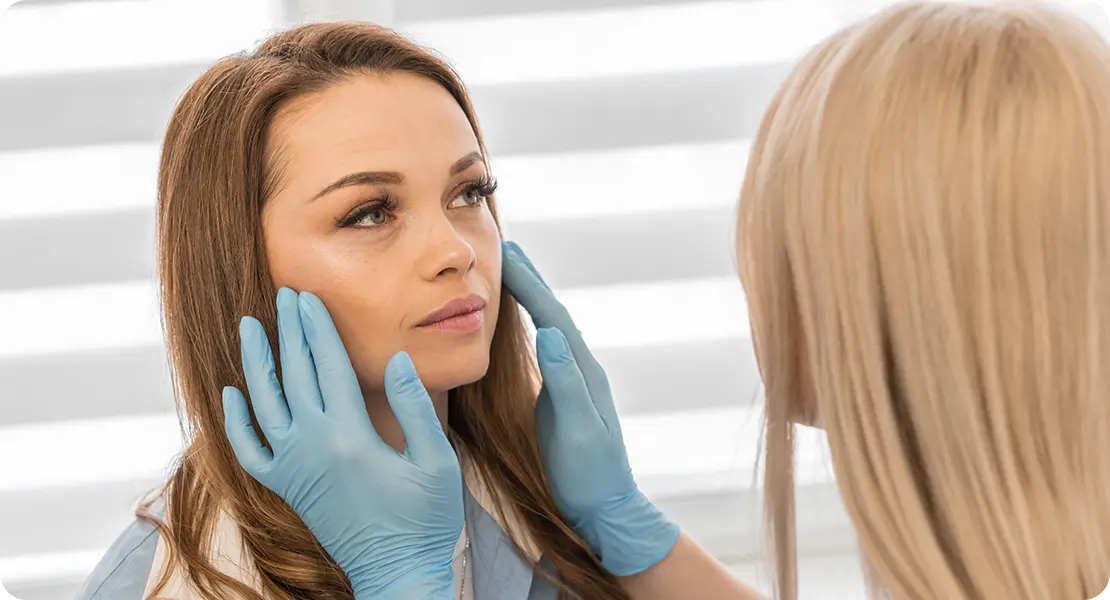Spotting yellowish bumps near the eyes can be unsettling. Because the face is the most visible part of our body, any change whether small marks, raised growths, or colour shifts quickly catches attention and may trigger worry. In many cases, these yellow patches or bumps are a condition known as xanthelasma.
Xanthelasma appears as soft, yellowish growths on or around the eyelids. They may look like flat plaques or slightly raised lumps, often occurring symmetrically on both eyes. At first glance, they might be mistaken for other skin issues such as milia, syringomas, or even cholesterol spots, but xanthelasma has a very distinct appearance and is generally harmless in itself.
Even though these bumps don’t usually cause pain, itching, or irritation, they can be troubling for two main reasons. Firstly, they are highly visible, often leading to cosmetic concerns and a dip in self-confidence. Secondly and perhaps more importantly they can sometimes signal an underlying health condition, most commonly elevated cholesterol or lipid levels in the bloodstream. For some people, xanthelasma may be the first visible sign that their cardiovascular health requires closer attention.
Understanding what xanthelasma is, how it develops, and what it might mean for your overall health is essential. Dermatologists often stress that while the condition itself is benign, it should not be ignored. Proper evaluation can rule out any hidden medical concerns and help you explore safe, effective treatment options.
In this guide, we’ll break down everything you need to know, including:
- What xanthelasma is and how it differs from other eyelid bumps.
- Causes and risk factors, including the link to cholesterol and lipid disorders.
- Diagnosis and why professional evaluation matters.
- Treatment options, ranging from non-invasive approaches to dermatological procedures.
- Long-term outlook and whether xanthelasma can come back after removal.
By the end, you’ll have a clear understanding of this condition and what steps you can take if you notice yellow bumps near your eyes.
What Is Xanthelasma?

Xanthelasma is a dermatological condition in which soft, yellowish plaques or bumps form on or around the eyelids. These patches usually develop close to the inner corners of the eyes, but they can appear on both the upper and lower lids. In some people, the bumps are small and subtle, while in others they may enlarge over time, creating more noticeable, flat, or slightly raised plaques that spread across the eyelid skin.
The underlying cause of these patches is the accumulation of cholesterol and lipid deposits within the superficial layers of the skin. Unlike other common eyelid lesions such as milia (tiny white keratin-filled cysts) or syringomas (sweat gland overgrowths), xanthelasma is directly connected to how the body processes fats. These deposits do not form randomly they often reflect changes in the body’s lipid metabolism, meaning the way cholesterol and triglycerides are stored and moved around in the bloodstream.
Although anyone can develop xanthelasma, it is most frequently seen in adults over the age of 40. Studies suggest that the likelihood increases with age, as lipid regulation naturally changes and metabolic conditions become more common. Women are slightly more predisposed than men, and certain genetic factors also play a role, especially if there is a family history of high cholesterol or early heart disease.
From a medical standpoint, xanthelasma itself is considered benign. The bumps are not cancerous, they do not usually cause pain, and they rarely interfere with eyelid function. However, they can become a cosmetic concern, particularly because of their location on such a prominent part of the face. Many people find them distracting, difficult to conceal with makeup, and ultimately damaging to their confidence.
What makes xanthelasma important to recognise is its potential connection to cardiovascular health. In a significant number of cases, individuals with xanthelasma are found to have elevated cholesterol, triglycerides, or other lipid abnormalities. This does not mean that every person with xanthelasma will have heart disease, but it can serve as an early warning sign that a deeper health check is needed. For some people, the appearance of these yellow plaques is the first visible indicator that their cardiovascular system may be at risk.
Because of this link, dermatologists often recommend that anyone with new or unexplained xanthelasma undergo a blood lipid profile test to measure cholesterol levels. Even if the plaques themselves are not medically dangerous, their presence may highlight an underlying condition that requires attention, such as high cholesterol, diabetes, thyroid disease, or other metabolic imbalances.
In summary, xanthelasma is more than just a cosmetic skin change. While the plaques themselves are harmless, they may carry an important message about your overall health, particularly your heart and blood vessels. Recognising the condition early and seeking proper evaluation can help you manage both its appearance and any hidden risk factors that might be contributing to its development.
Possible Causes of Xanthelasma
The appearance of xanthelasma is not random. These yellowish plaques form because of changes in the way the body processes and stores fats, particularly cholesterol. While the condition itself is benign, it often reflects underlying imbalances in lipid metabolism or related health conditions. Below are the most recognised causes and contributing factors:
1. High Cholesterol Levels
One of the strongest associations with xanthelasma is high blood cholesterol, especially elevated levels of low-density lipoprotein (LDL) often known as “bad” cholesterol. When LDL is too high, cholesterol can begin to deposit in blood vessel walls and tissues, including the delicate skin of the eyelids. Over time, these deposits manifest as the yellow plaques seen in xanthelasma. Even though not every patient with the condition has raised cholesterol, its presence often prompts dermatologists to recommend a lipid profile test. Identifying high cholesterol early is important, as it can significantly reduce long-term risks such as atherosclerosis and heart disease.
2. Lipid Metabolism Disorders
Beyond high cholesterol, certain lipid disorders can play a key role. These include conditions where the body struggles to regulate fats correctly, leading to abnormal levels of cholesterol and triglycerides in the blood. For example, familial hypercholesterolaemia, a hereditary condition, causes dangerously high cholesterol from a young age and is a recognised risk factor for xanthelasma. Similarly, hypertriglyceridaemia excess triglycerides in the blood may also contribute to fatty deposits forming under the skin. For many individuals, xanthelasma is the first external sign of these internal metabolic imbalances.
3. Genetic Predisposition
Genetics strongly influence who is more likely to develop xanthelasma. People with a family history of early cardiovascular disease, high cholesterol, or previous cases of xanthelasma are naturally more prone. Even individuals who follow a balanced diet and maintain a healthy lifestyle may still develop the condition if they have inherited lipid metabolism issues. This is why doctors often recommend screening for cholesterol and triglyceride levels in family members when xanthelasma is diagnosed.
4. Underlying Health Conditions
Certain systemic health problems can make xanthelasma more likely to appear. Diabetes mellitus, for instance, affects how the body uses and stores energy from food, often leading to raised triglycerides and abnormal cholesterol patterns. Liver disease can impair fat processing, while thyroid dysfunction particularly hypothyroidism slows metabolism and contributes to lipid imbalances. Additionally, people with obesity or metabolic syndrome are at higher risk because these conditions are directly linked to disruptions in fat metabolism.
5. Lifestyle Factors
While genetics and medical conditions set the stage, lifestyle choices can also play a significant role. A diet rich in saturated fats, processed foods, and trans fats increases LDL cholesterol levels, making xanthelasma more likely to form. Smoking accelerates lipid oxidation and contributes to cardiovascular strain, while excessive alcohol consumption raises triglyceride levels, both of which heighten risk. Lack of regular physical activity further compounds the problem, as exercise helps regulate cholesterol balance in the body.
6. Idiopathic Cases
It’s worth noting that some people develop xanthelasma without any obvious cholesterol abnormalities or underlying disease. These are known as idiopathic cases. Even when blood tests come back normal, the plaques can still form, suggesting that other subtle factors such as localised changes in skin lipid handling or yet unidentified genetic influences may be at work.
Diagnosis and Health Checks

Getting a proper diagnosis is an important first step when yellowish bumps appear around the eyes. While xanthelasma has a fairly distinct appearance, it is always best to have it confirmed by a dermatologist, both to rule out other skin conditions and to identify any possible underlying health concerns.
1. Clinical Skin Examination
A dermatologist will begin with a visual and physical examination of the affected area. Xanthelasma typically presents as soft, flat or slightly raised, yellowish plaques on the eyelids, often near the inner corners of the eyes. Its symmetrical appearance and colour often make it relatively straightforward to identify. The doctor may gently press or examine the texture to distinguish it from other lesions such as milia, syringomas, or sebaceous hyperplasia, which can sometimes appear similar but differ in composition.
2. Blood Tests and Lipid Profile
Since xanthelasma is closely linked to cholesterol and fat metabolism, dermatologists often recommend a fasting blood test to evaluate lipid levels. This includes measuring:
- Total cholesterol
- LDL (“bad”) cholesterol
- HDL (“good”) cholesterol
- Triglycerides
These results provide insight into whether the plaques are a cosmetic issue alone or a visible marker of a deeper metabolic imbalance. Identifying high cholesterol early allows patients to make lifestyle changes or start treatment to reduce long-term cardiovascular risk.
3. Screening for Underlying Conditions
If blood test results show abnormal lipid levels, further checks may be carried out to uncover possible underlying conditions. These may include tests for diabetes, thyroid function, or liver health, since these disorders can all disrupt fat metabolism and contribute to xanthelasma formation.
4. Ruling Out Other Skin Conditions
Not all yellow bumps around the eyes are xanthelasma. A dermatologist will carefully rule out other possibilities such as:
- Milia – tiny, white or yellow keratin-filled cysts.
- Syringomas – benign sweat gland growths that appear as small, skin-coloured or yellowish bumps.
- Sebaceous gland hyperplasia – enlarged oil glands that may look similar.
- Xanthomas in other areas of the body, which can indicate systemic lipid issues.
This step ensures that the correct condition is being treated and that no other dermatological or systemic problem is overlooked.
5. Cardiovascular Risk Assessment
For many patients, the discovery of xanthelasma serves as a wake-up call for heart health. Dermatologists may recommend follow-up with a general physician or cardiologist to assess blood pressure, weight, and family history of heart disease. In this way, a skin finding that seems purely cosmetic may actually help prevent more serious health issues in the future.
Dermatologist Treatments for Xanthelasma
For most people, the decision to treat xanthelasma is based on appearance rather than medical urgency. While the plaques themselves are harmless, they can be difficult to conceal with makeup, and many patients find them frustrating or embarrassing. Dermatologists provide a range of effective treatment options, each with its own benefits, recovery time, and potential risks. The best choice often depends on the size, thickness, location, and number of plaques, as well as the patient’s overall health and preferences.
1. Laser Removal
Laser therapy is one of the most advanced and widely used methods for treating xanthelasma. Dermatologists commonly rely on carbon dioxide (CO₂) lasers or erbium:YAG lasers, which allow highly precise targeting of the affected tissue. The laser beam vaporises the cholesterol deposits while leaving the surrounding skin largely untouched.
This precision is particularly important for treatment around the eyelids, where the skin is very thin and sensitive. Compared to traditional surgical methods, lasers usually result in less bleeding, faster healing, and a lower risk of scarring. Patients may experience redness, swelling, or mild discomfort in the days following treatment, but these side effects generally settle within a week or two. In some cases, more than one session may be needed to fully clear the plaques, especially if they are thicker or more widespread.
2. Surgical Excision
For larger or more deeply embedded lesions, dermatologists may recommend surgical excision. In this procedure, the xanthelasma is carefully cut away with fine surgical instruments under local anaesthesia. Surgery provides immediate removal, which can be reassuring for patients who want fast, definitive results.
The main drawback is the risk of scarring, though skilled dermatologists use delicate techniques to keep scars as minimal as possible. Stitches are sometimes required, particularly if the lesion is large, and recovery can take one to two weeks. Despite this, surgery remains a reliable option, particularly for patients whose plaques do not respond well to other treatments.
3. Chemical Peels
Chemical peeling involves applying a solution commonly trichloroacetic acid (TCA) to the affected skin. The peel causes controlled exfoliation of the top skin layers, which gradually reduces the thickness and visibility of the cholesterol deposits. Over time, the treated area heals with a smoother texture and lighter appearance.
This method is best suited for smaller or flatter plaques, and multiple treatments may be required to achieve the desired results. While chemical peels are less invasive than surgery, they do carry some risks, including temporary redness, irritation, and changes in skin pigmentation, particularly in individuals with darker skin tones. However, when performed under dermatological supervision, chemical peels can be a safe and cost-effective way to improve xanthelasma.
4. Cryotherapy
Cryotherapy uses liquid nitrogen to freeze and destroy abnormal tissue. The extreme cold causes the cholesterol deposits to break down, and the area then heals with new skin. While effective for many skin growths, cryotherapy is used less often for xanthelasma because the eyelid skin is so delicate. Risks include scarring, pigment changes, and prolonged healing, which makes dermatologists cautious when recommending this option. It may occasionally be considered for patients with small plaques who prefer a non-surgical approach.
5. Radiofrequency and Electrocautery
Other techniques involve the use of controlled heat to remove the plaques. With radiofrequency ablation or electrocautery, a fine probe delivers heat to the targeted area, effectively destroying the cholesterol deposits. Like laser therapy, these methods are precise and can be performed under local anaesthesia in an outpatient setting. Healing usually occurs within a couple of weeks, with minimal downtime, though some patients may need repeat sessions.
6. Management of Underlying Cholesterol
Even if the plaques are removed successfully, xanthelasma often returns if the underlying cholesterol imbalance is not corrected. For this reason, dermatologists emphasise the importance of treating the root cause. Management typically includes:
- Lifestyle adjustments: Adopting a diet low in saturated fats and trans fats, increasing intake of fruits, vegetables, and whole grains, reducing alcohol, and avoiding smoking.
- Regular exercise: Physical activity helps raise HDL (“good”) cholesterol and lower LDL (“bad”) cholesterol and triglycerides.
- Medications: If lifestyle changes are not enough, a physician may prescribe cholesterol-lowering drugs such as statins, fibrates, or ezetimibe.
Addressing cholesterol not only helps reduce the likelihood of recurrence but also significantly improves overall cardiovascular health, lowering the long-term risk of heart disease and stroke.
7. Combination Approaches
In many cases, dermatologists may recommend a combination of treatments. For example, a patient might undergo laser removal for visible plaques while also starting statin therapy to control cholesterol. This dual approach ensures that the cosmetic concern is managed while also protecting long-term health.
Final Thought: Treating Xanthelasma Safely and Effectively
Xanthelasma can be managed effectively with professional care, whether through laser, surgery, or chemical treatments. If you notice yellow bumps near your eyes, it’s wise to consult a dermatologist in London who can assess both the cosmetic concerns and potential health implications.
References:
- Nair, P.A. (2017) Xanthelasma palpebrarum – a brief review, Cutaneous and Ocular Toxicology. Available at: https://www.ncbi.nlm.nih.gov/pmc/articles/PMC5739544/
- Rai, A. et al. (2022) Dyslipidemia in Patients with Xanthelasma Palpebrarum…, JNMA: Journal of the Nepal Medical Association. Available at: https://www.ncbi.nlm.nih.gov/pmc/articles/PMC9275457/
- Malekzadeh, H. (2023) A Practical Review of the Management of Xanthelasma Palpebrarum, Plastic and Reconstructive Surgery Global Open. Available at: https://www.ncbi.nlm.nih.gov/pmc/articles/PMC10208694/
- Lustig-Barzelay, Y. et al. (2025) Association Between Xanthelasma Palpebrarum with Cardiovascular Risk and Dyslipidemia: A Case Control Study, Ophthalmology, 132(2), pp. 164–169. DOI: 10.1016/j.ophtha.2024.07.033. Available at: https://pubmed.ncbi.nlm.nih.gov/39111668/
- Xanthelasma: Background, Pathophysiology, Epidemiology (2024), eMedicine, Medscape. Available at: https://emedicine.medscape.com/article/1213423-overview
